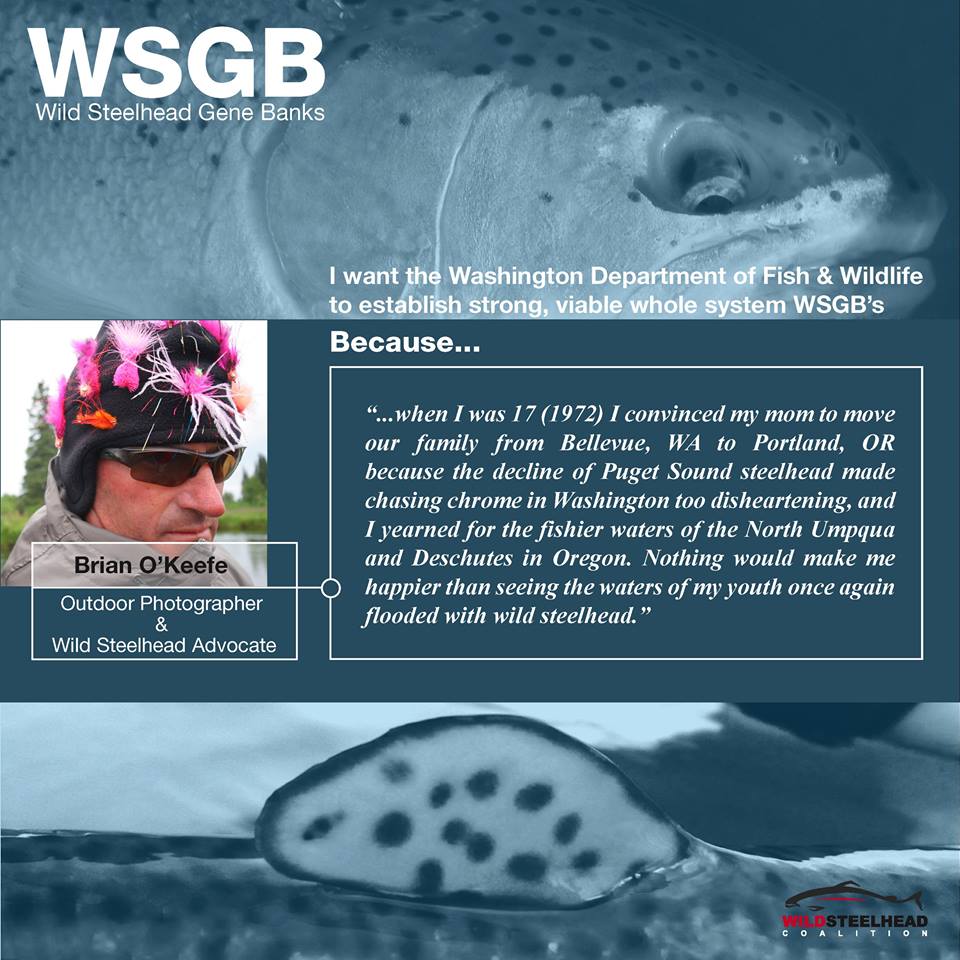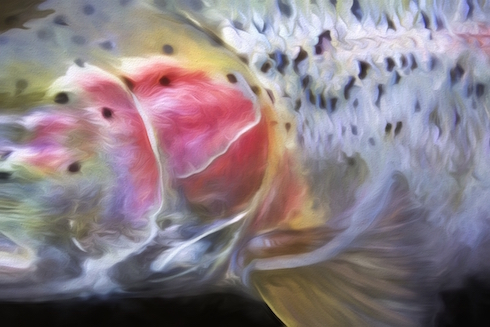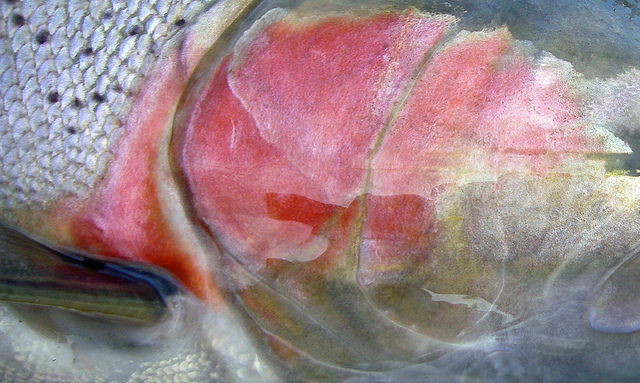Steelhead Film Shoot
 Friday, September 18, 2015 at 12:04AM
Friday, September 18, 2015 at 12:04AM 
The goal was simple: Travel to nearly untouched, far-northern waters to make a conservation film centered around steelhead.
LINK (via:Dylan Tomine)
 Friday, September 18, 2015 at 12:04AM
Friday, September 18, 2015 at 12:04AM 
The goal was simple: Travel to nearly untouched, far-northern waters to make a conservation film centered around steelhead.
LINK (via:Dylan Tomine)
 Tuesday, August 11, 2015 at 12:10AM
Tuesday, August 11, 2015 at 12:10AM 
Runs were so depleted, Brian O'Keefe convinced his Mom to move the family to Oregon.
 Thursday, July 23, 2015 at 12:08AM
Thursday, July 23, 2015 at 12:08AM Click to see image full size
On Tuesday night a coalition of wild fish advocates testified in front of the Washington Department of Fish and Wildlife in support of a strategy to conserve and recover wild steelhead by establishing a network of wild stock gene banks across the state. Of all the watersheds under consideration the overwhelming percentage of attendees testified in favor of designating the three watersheds shown above.
For those of you who are unable to attend the remaining public hearings, and those of you who from outside the region who care about wild steelhead, please submit your comments in support of the same three watersheds.
Submit your comments HERE.
 TAKE ACTION!!!!,
TAKE ACTION!!!!,  wild steelhead in
wild steelhead in  Action,
Action,  Species
Species  Tuesday, July 21, 2015 at 12:00AM
Tuesday, July 21, 2015 at 12:00AM  Image: USFWS/Rick Kuyper
Image: USFWS/Rick Kuyper
Faster than a frog can hop over a drought-shrunken creek, San Francisco water officials' plan to help restore wild fish has spiraled into a regulatory debate highlighting the difficulty of trying to undo damage to one species without hurting others.
LINK (via: Contra Costa Times)
 fish in the news,
fish in the news,  wild steelhead in
wild steelhead in  Conservation,
Conservation,  Science,
Science,  Species
Species  Monday, July 20, 2015 at 12:10AM
Monday, July 20, 2015 at 12:10AM 
A VERY important action alert from the Wild Steelhead Coalition
Help protect and recover threatened populations of wild steelhead in once prolific Puget Sound rivers by telling Washington Department of Fish and Wildlife (WDFW) to establish strong, effective wild steelhead gene banks.
Among other culprits of steelhead decline, hatcheries are a contributing factor to why Puget Sound steelhead populations have plummeted to roughly three percent of their historical abundance. Decades of management that prioritized hatchery plants at the expense of wild steelhead returns are part of why these incredible fish are now listed as threatened under the Endangered Species Act.
Recognizing this problem, the Wild Steelhead Coalition and its members have worked tirelessly since its founding to mitigate the negative impact that hatchery steelhead have on their wild counterparts, including seeking to reduce or revise hatchery plants in watersheds with sufficient potential for wild steelhead recovery. But now more than ever before, we need to take action.
Through years of hard work and extensive collaboration with Native Fish Society, Wild Fish Conservancy, and the Conservation Angler, we have been able to take important, incremental steps to help reduce the negative impacts of steelhead hatcheries. However, in all of our years of work, we have never before had an opportunity like this in Puget Sound to use public input and the best available science to transform rivers into wild steelhead gene banks where the harm of hatchery steelhead will be forever eliminated.
While the creation of at least three wild steelhead gene banks is required under Washington’s State Steelhead Management Plan, WDFW has significant latitude over how many rivers and which rivers they designate as gene banks. With hatchery proponents working furiously to limit these designations to three smaller tributaries, it is critical that wild steelhead advocates make their voices heard and establish river basins that have diversity, abundance and will provide refuge through a changing climate.
Over the next two weeks, WDFW will be hosting three meetings for citizens to express their opinions publicly on the designation of Wild Steelhead Gene Banks. Please attend one of these meetings and make your voice heard.
A comment form is also available online for those of you unable to attend the meeting but wishing to submit comments.
 Thursday, April 30, 2015 at 12:19AM
Thursday, April 30, 2015 at 12:19AM 
Steelhead are a wonder of nature. Their daunting journey from the river of their birth to the ocean and back is awe-inspiring. Their sheer strength and ability to traverse seemingly impassable waters is nothing short of remarkable. And they have exceptional power, size, and beauty. These attributes as well as their indelible mystique combine to make steelhead the pinnacle of freshwater fishing.
Legend has it that there were once so many steelhead and salmon in Washington’s rivers that you could walk across the water on the backs of fish. But gross mismanagement of these rivers for the last century has decimated these steelhead and salmon populations, relegating the stirring images of rivers full of fish to a distant memory. Now wild steelhead populations represent a dismal 3% of their historic numbers in Puget Sound, yet 66% of their historical habitat remains. As a result, these fish are listed under the Endangered Species Act.
According to the National Oceanic and Atmospheric Administration (NOAA) – the federal agency charged with protecting these imperiled fish – government-operated steelhead hatcheries are one of the four known causes for the precipitous decline of wild steelhead populations. Despite this understanding, NOAA is currently undermining critical federal regulations in a politically motivated effort to expedite approval of Puget Sound hatchery programs.
This undercutting of federal procedures represents a significant departure for NOAA, which spent the last 11 years rigorously developing a comprehensive environmental review of hatchery program’s impact in Puget Sound. NOAA was expected to release the review’s findings this spring but at the last minute suddenly abandoned this 11-year comprehensive review. In its place, NOAA is now conducting a cursory environmental assessment for three hatcheries in three different watersheds.
NOAA is trying to justify this approach as simply a strategy adjustment. However, this dramatic reversal is much more than that. In reality, it is a precedent setting approach that has the potential to undercut critical protections for not just steelhead but all endangered species, including orca whales, wolves, and salmon. Left unchecked, this decision could have far-reaching implications as it could make federal approval easier for destructive projects across the United States.
Time is running out, but we still have the potential to stop NOAA from setting this dangerous precedent that will imperil threatened steelhead populations and all ESA-listed species. Please submit a comment below and tell NOAA you will not stand for them undermining federal environmental protections for threatened steelhead.
To learn more about the environmental protections NOAA is undermining and the specifics of this environmental review process, please see below:
1. NOAA’s proposed Environmental Assessment (EA) is insufficient and violates the National Environmental Protection Act (NEPA)
• An environmental impact statement (EIS) is needed to fully evaluate the cumulative effects of all Puget Sound hatchery programs on threatened & endangered species—including steelhead—throughout Puget Sound.
• Puget Sound hatchery programs can have significant adverse impacts on ESA-listed wild salmon and steelhead, making the proposed approval of the three steelhead hatcheries controversial, thus meeting two of NEPA’s thresholds for an EIS.
2. NOAA has not provided adequate time to review the EA and associated technical documents
• NOAA released the EA on 3/26 with a due date for comments on 4/27, which amounted to 33 days. According to NOAA, all comments submitted from 3/26-4/13 were lost because of NOAA technical difficulties, with no way to contact those that submitted comments. A new due date was set for 5/4. This new due date results in a total of only 21 days to submit comments on over 1,400 pages included in the EA, Hatchery & Genetic Management Plans, and referenced literature.
3. NOAA has not completed a Puget Sound Steelhead Recovery Plan
• A recovery plan is required by law under the ESA; Puget Sound steelhead were ESA-listed eight years ago in 2007.
• A recovery plan is fundamental to an appropriate EA or EIS. It is needed in order to determine what levels of hatchery impacts to each Puget Sound steelhead population, if any, are compatible with recovery.
Submit your comments: Tell NOAA you will not stand for them undermining federal environmental protections for threatened steelhead
Please submit your comments no later than 5:00 p.m. Pacific time on May 4, 2015.
 tale action,
tale action,  wild fish conservancy,
wild fish conservancy,  wild steelhead in
wild steelhead in  Action
Action